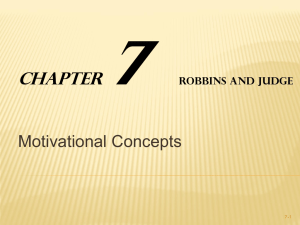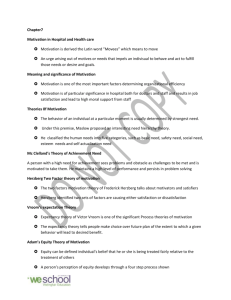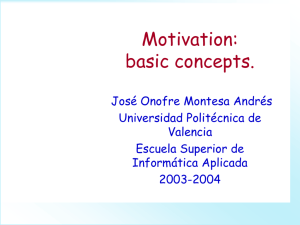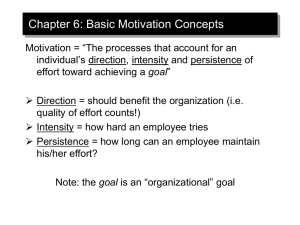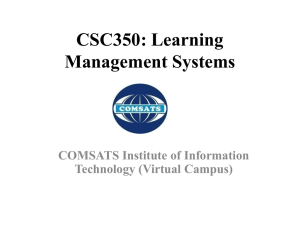Motivation Concepts: Theories & Application
advertisement
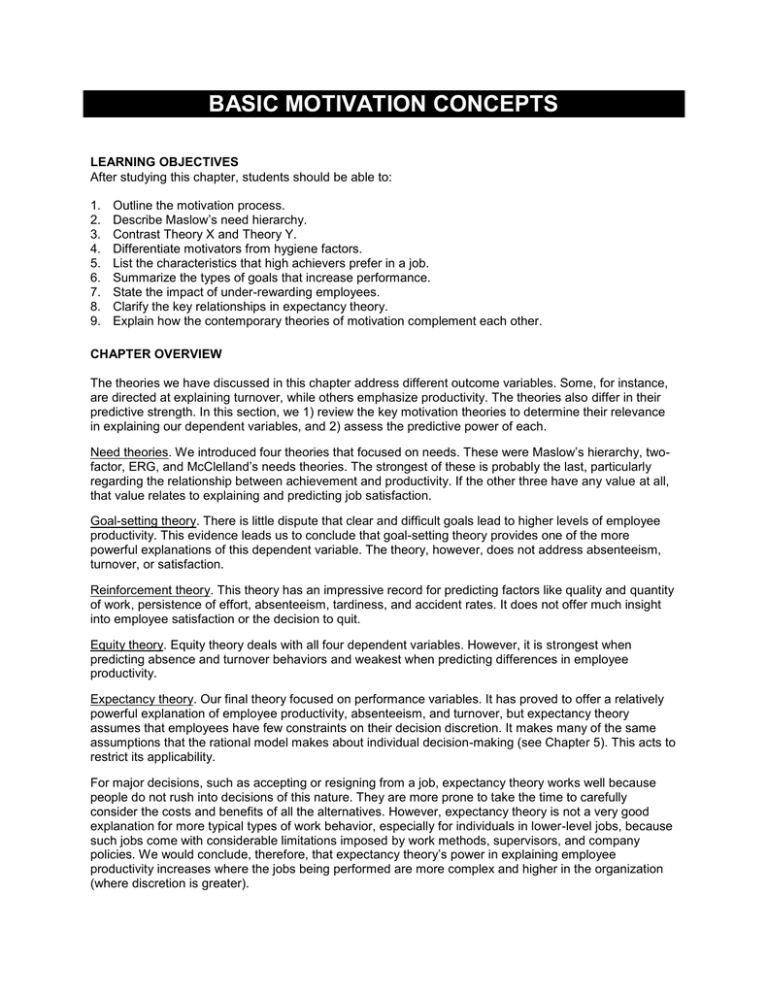
BASIC MOTIVATION CONCEPTS LEARNING OBJECTIVES After studying this chapter, students should be able to: 1. 2. 3. 4. 5. 6. 7. 8. 9. Outline the motivation process. Describe Maslow’s need hierarchy. Contrast Theory X and Theory Y. Differentiate motivators from hygiene factors. List the characteristics that high achievers prefer in a job. Summarize the types of goals that increase performance. State the impact of under-rewarding employees. Clarify the key relationships in expectancy theory. Explain how the contemporary theories of motivation complement each other. CHAPTER OVERVIEW The theories we have discussed in this chapter address different outcome variables. Some, for instance, are directed at explaining turnover, while others emphasize productivity. The theories also differ in their predictive strength. In this section, we 1) review the key motivation theories to determine their relevance in explaining our dependent variables, and 2) assess the predictive power of each. Need theories. We introduced four theories that focused on needs. These were Maslow’s hierarchy, twofactor, ERG, and McClelland’s needs theories. The strongest of these is probably the last, particularly regarding the relationship between achievement and productivity. If the other three have any value at all, that value relates to explaining and predicting job satisfaction. Goal-setting theory. There is little dispute that clear and difficult goals lead to higher levels of employee productivity. This evidence leads us to conclude that goal-setting theory provides one of the more powerful explanations of this dependent variable. The theory, however, does not address absenteeism, turnover, or satisfaction. Reinforcement theory. This theory has an impressive record for predicting factors like quality and quantity of work, persistence of effort, absenteeism, tardiness, and accident rates. It does not offer much insight into employee satisfaction or the decision to quit. Equity theory. Equity theory deals with all four dependent variables. However, it is strongest when predicting absence and turnover behaviors and weakest when predicting differences in employee productivity. Expectancy theory. Our final theory focused on performance variables. It has proved to offer a relatively powerful explanation of employee productivity, absenteeism, and turnover, but expectancy theory assumes that employees have few constraints on their decision discretion. It makes many of the same assumptions that the rational model makes about individual decision-making (see Chapter 5). This acts to restrict its applicability. For major decisions, such as accepting or resigning from a job, expectancy theory works well because people do not rush into decisions of this nature. They are more prone to take the time to carefully consider the costs and benefits of all the alternatives. However, expectancy theory is not a very good explanation for more typical types of work behavior, especially for individuals in lower-level jobs, because such jobs come with considerable limitations imposed by work methods, supervisors, and company policies. We would conclude, therefore, that expectancy theory’s power in explaining employee productivity increases where the jobs being performed are more complex and higher in the organization (where discretion is greater). A Guide through the Maze. Exhibit 6-10 summarizes what we know about the power of the more well known motivation theories to explain and predict our four dependent variables. While based on a wealth of research, it also includes some subjective judgments. However, it does provide a reasonable guide through the motivation theory maze. WEB EXERCISES At the end of each chapter of this instructor’s manual you will find suggested exercises and ideas for researching the WWW on OB topics. The exercises “Exploring OB Topics on the Web” are set up so that you can simply photocopy the pages, distribute them to your class, and make assignments accordingly. You may want to assign the exercises as an out-of-class activity or as lab activities with your class. Within the lecture notes the graphic will note that there is a WWW activity to support this material. The chapter opens with the story of EMC data storage, which is among employers that are having employees walk on 1500 degree coals. While there is no proof that walking on coals increases accomplishment by snuffing out fear, the anecdotal evidence from some of the senior employees suggests that does motivate employees at EMC to tackle the difficult jobs. CHAPTER OUTLINE A. What is Motivation? 1. Many people incorrectly view motivation as a personal trait—that is, some have it and others do not. Motivation is the result of the interaction of the individual and the situation. 2. Definition: Motivation is “the processes that account for an individual’s intensity, direction, and persistence of effort toward attaining a goal.” 3. We will narrow the focus to organizational goals in order to reflect our singular interest in work-related behavior. 4. The three key elements of our definition are intensity, direction, and persistence: Intensity is concerned with how hard a person tries. This is the element most of us focus on when we talk about motivation. Direction is the orientation that benefits the organization. Persistence is a measure of how long a person can maintain his/her effort. Motivated individuals stay with a task long enough to achieve their goal. B. Early Theories of Motivation 1. In the 1950s three specific theories were formulated and are the best known: hierarch of needs theory, Theories X and Y, and the two-factor theory. 2. These early theories are important to understand because they represent a foundation from which contemporary theories have grown. Practicing managers still regularly use these theories and their terminology in explaining employee motivation. Notes: C. Hierarchy of Needs Theory Notes: 1. Abraham Maslow’s hierarchy of needs is the most well-known theory of motivation. He hypothesized that within every human being there exists a hierarchy of five needs: (See Exhibit 6-1). Physiological: Includes hunger, thirst, shelter, sex, and other bodily needs Safety: Includes security and protection from physical and emotional harm Social: Includes affection, belongingness, acceptance, and friendship Esteem: Includes internal esteem factors such as self-respect, autonomy, and achievement; and external esteem factors such as status, recognition, and attention Self-actualization: The drive to become what one is capable of becoming; includes growth, achieving one’s potential, and self-fulfillment 2. As a need becomes substantially satisfied, the next need becomes dominant. No need is ever fully gratified; a substantially satisfied need no longer motivates. 3. Maslow separated the five needs into higher and lower orders. Physiological and safety needs are described as lower-order. Social, esteem, and self-actualization are as higher-order needs Higher-order needs are satisfied internally. Lower-order needs are predominantly satisfied externally. 4. Maslow’s need theory has received wide recognition, particularly among practicing managers. Research does not generally validate the theory. 5. Maslow provided no empirical substantiation, and several studies that sought to validate the theory found no support for it. Instructor Note: At this point in the lecture you may want to introduce the TEAM EXERCISE: What Do People Want from Their Jobs? found in the text. The purpose of the exercise is to help students better understand the importance of Herzberg’s model. It illustrates the difference between what motivates individuals versus what causes only satisfaction. D. Theory X and Theory Y 1. Douglas McGregor concluded that a manager’s view of the nature of human beings is based on a certain grouping of assumptions and he or she tends to mold his or her behavior toward employees according to these assumptions. 2. Theory X assumptions are basically negative. Employees inherently dislike work and, whenever possible, will attempt to avoid it. Since employees dislike work, they must be coerced, controlled, or threatened with punishment. Employees will avoid responsibilities and seek formal direction whenever possible. Most workers place security above all other factors and will display little ambition. Notes: D. Theory X and Theory Y (cont.) Notes: 3. Theory Y assumptions are basically positive. Employees can view work as being as natural as rest or play. People will exercise self-direction and self-control if they are committed to the objectives. The average person can learn to accept, even seek, responsibility. The ability to make innovative decisions is widely dispersed throughout the population. 4. What are the implications for managers? This is best explained by using Maslow’s framework: Theory X assumes that lower-order needs dominate individuals. Theory Y assumes that higher-order needs dominate individuals. McGregor himself held to the belief that Theory Y assumptions were more valid than Theory X. There is no evidence to confirm that either set of assumptions is valid. Either Theory X or Theory Y assumptions may be appropriate in a particular situation. Instructor Note: At this point in the lecture you may want to introduce the MYTH OR SCIENCE?: “People Are Inherently Lazy” found in the text and at the end of these chapter notes. The discussion of the material will provide students the opportunity to identify Theory X or Theory Y theories in practice. MYTH OR SCIENCE? – “People Are Inherently Lazy” This statement is false on two levels. All people are not inherently lazy, and “laziness” is more a function of the situation than an inherent individual characteristic. If this statement is meant to imply that all people are inherently lazy, the evidence strongly indicated the contrary. Many people today suffer from the opposite affliction—they are overly busy, overworked, and suffer from over-exertion. Whether externally motivated or internally-driven, a good portion of the labor force is anything but lazy. Managers frequently draw that conclusion by watching a few of their employees who may be lazy at work, but these same employees are often quite industrious off the job. People’s need structures differ. As accompanying Exhibit 6-2 illustrates, evidence indicates that work needs differ by gender, age income level, job type, and level in the organization. Unfortunately, work often ranks low in its ability to satisfy individual needs. Very few people are perpetually lazy. They merely differ in terms of the activities they most enjoy doing. Class Exercise: Before reviewing this situation, discuss with students the task of working on team projects. What constitutes working hard on a team project? What motivates them to work hard? Why would a team member not work hard? Not carry his/her fair share? How could they make the team project as important to the other team members as it is to them? E. Two-Factor Theory Notes: 1. The Two-Factor Theory is sometimes also called motivation-hygiene theory. 2. Proposed by psychologist Frederick Herzberg when he investigated the question, “What do people want from their jobs?” He asked people to describe, in detail, situations in which they felt exceptionally good or bad about their jobs. These responses were then tabulated and categorized. 3. From the categorized responses, Herzberg concluded: Intrinsic factors, such as advancement, recognition, responsibility, and achievement seem to be related to job satisfaction. Dissatisfied respondents tended to cite extrinsic factors, such as supervision, pay, company policies, and working conditions. The opposite of satisfaction is not dissatisfaction. Removing dissatisfying characteristics from a job does not necessarily make the job satisfying. 4. Job satisfaction factors are separate and distinct from job dissatisfaction factors. Managers who eliminate job dissatisfaction factors may not necessarily bring about motivation. 5. When hygiene factors are adequate, people will not be dissatisfied; neither will they be satisfied. To motivate people, emphasize factors intrinsically rewarding that are associated with the work itself or to outcomes directly derived from it. 6. Criticisms of the theory: The procedure that Herzberg used is limited by its methodology. The reliability of Herzberg’s methodology is questioned. No overall measure of satisfaction was utilized. Herzberg assumed a relationship between satisfaction and productivity, but the research methodology he used looked only at satisfaction, not at productivity. 7. Regardless of criticisms, Herzberg’s theory has been widely read, and few managers are unfamiliar with his recommendations. The popularity of vertically expanding jobs to allow workers greater responsibility can probably be attributed to Herzberg’s findings. Contemporary Theories of Motivation Contemporary Theories of Motivation The following theories are considered contemporary not because they necessarily were developed recently, but because they represent the current state of the art in explaining employee motivation. A. ERG Theory 1. Clayton Alderfer reworked Maslow’s need hierarchy to align it with the empirical research. His revised need hierarchy is labeled ERG theory. 2. Alderfer argues that there are three groups of core needs: existence, Notes: relatedness, and growth. A. ERG Theory (cont.) 3. The existence group Provides our basic material existence requirements They include Maslow’s physiological and safety needs. 4. Relatedness The desire we have for maintaining important interpersonal relationships These social and status desires require interaction with others. They align with Maslow’s social need and the external component. 5. Growth needs An intrinsic desire for personal development These include the intrinsic component from Maslow’s esteem category and the characteristics included under self-actualization. 6. In addition to collapsing Maslow’s five into three, Alderfer’s ERG theory also differs from Maslow’s in that: More than one need may be operative at the same time. If the gratification of a higher-level need is stifled, the desire to satisfy a lower-level need increases. ERG theory does not assume that there exists a rigid hierarchy. A person can be working on growth even though existence or relatedness needs are unsatisfied, or all three need categories could be operating at the same time. 7. ERG theory also contains a frustration-regression dimension. Maslow argued that an individual would stay at a certain need level until that need was satisfied. ERG argues that multiple needs can be operating as motivators at the same time. ERG theory notes that when a higher-order need level is frustrated, the individual’s desire to increase a lower-level need takes place. 8. ERG theory is more consistent with our knowledge of individual differences among people. Variables such as education, family background, and cultural environment can alter the importance or driving force that a group of needs holds for a particular individual. The evidence demonstrating that people in other cultures rank the need categories differently would be consistent with ERG theory. B. McClelland’s Theory of Needs 1. The theory focuses on three needs: achievement, power, and affiliation. Need for achievement: The drive to excel, to achieve in relation to a set of standards, to strive to succeed Notes: Need for power: The need to make others behave in a way that they would not have behaved otherwise Need for affiliation: The desire for friendly and close interpersonal relationships B. McClelland’s Theory of Needs (cont.) 2. Some people have a compelling drive to succeed. They are striving for personal achievement rather than the rewards of success per se. This drive is the achievement need (nAch). 3. McClelland found that high achievers differentiate themselves from others by their desire to do things better. They seek personal responsibility for finding solutions to problems. They want to receive rapid feedback on their performance so they can tell easily whether they are improving or not. They can set moderately challenging goals. High achievers are not gamblers; they dislike succeeding by chance. High achievers perform best when they perceive their probability of success as 50-50. They like to set goals that require stretching themselves a little. 4. The need for power (nPow) is the desire to have impact, to be influential, and to control others. Individuals high in nPow enjoy being “in charge.” Strive for influence over others Prefer to be placed into competitive and status-oriented situations Tend to be more concerned with prestige and gaining influence over others than with effective performance 5. The third need isolated by McClelland is affiliation (nAfl). This need has received the least attention from researchers. Individuals with a high affiliation motive strive for friendship. Prefer cooperative situations rather than competitive ones Desire relationships involving a high degree of mutual understanding 6. Relying on an extensive amount of research, some reasonably well-supported predictions can be made based on the relationship between achievement need and job performance. First, as shown in Exhibit 6-4, individuals with a high need to achieve prefer job situations with personal responsibility, feedback, and an intermediate degree of risk. When these characteristics are prevalent, high achievers will be strongly motivated. Second, a high need to achieve does not necessarily lead to being a good manager, especially in large organizations. People with a high achievement need are interested in how well they do personally and not in influencing others to do well. Third, the needs for affiliation and power tend to be closely related to managerial success. The best managers are high in their need for power and low in their need for affiliation. Notes: Finally, employees have been successfully trained to stimulate their achievement need. Trainers have been effective in teaching individuals to think in terms of accomplishments, winning, and success, and then helping them to learn how to act in a high achievement way by preferring situations where they have personal responsibility, feedback, and moderate risks. C. Cognitive Evaluation Theory 1. In the late 1960s, one researcher proposed that the introduction of extrinsic rewards, such as pay, for work effort that had been previously intrinsically rewarding due to the pleasure associated with the content of the work itself, would tend to decrease the overall level of motivation. 2. This has come to be called the cognitive evaluation theory. Well researched and supported theorists have assumed that intrinsic motivations, such as achievement, etc., are independent of extrinsic motivators such as high pay, promotions, etc. 3. Cognitive evaluation theory suggests otherwise. When extrinsic rewards are used by organizations as payoffs for superior performance, the intrinsic rewards, which are derived from individuals doing what they like, are reduced. 4. The popular explanation is that the individual experiences a loss of control over his or her own behavior so that the previous intrinsic motivation diminishes. 5. Furthermore, the elimination of extrinsic rewards can produce a shift—from an external to an internal explanation—in an individual’s perception of causation of why he or she works on a task. 6. If the cognitive evaluation theory is valid, it should have major implications for managerial practices. If pay or other extrinsic rewards are to be effective motivators, they should be made contingent on an individual’s performance. Cognitive evaluation theorists would argue that this will tend only to decrease the internal satisfaction that the individual receives from doing the job. If correct, it would make sense to make an individual’s pay non-contingent on performance in order to avoid decreasing intrinsic motivation. 7. While supported in a number of studies, cognitive evaluation theory has also met with attacks, specifically on the methodology used and in the interpretation of the findings. 10. Further research is needed to clarify some of the current ambiguity. The evidence does lead us to conclude that the interdependence of extrinsic and intrinsic rewards is a real phenomenon. 11. Its impact on employee motivation at work may be considerably less than originally thought. First, many of the studies testing the theory were done with students. Second, evidence indicates that very high intrinsic motivation levels are strongly resistant to the detrimental impacts of extrinsic rewards. The theory may have limited applicability to work organizations because most low-level jobs are not inherently satisfying enough to foster high intrinsic interest, and many managerial and professional positions offer Notes: intrinsic rewards. D. Goal-Setting Theory 1. In the late 1960s, Edwin Locke proposed that intentions to work toward a goal are a major source of work motivation. 2. Goals tell an employee what needs to be done and how much effort is needed. The evidence strongly supports the value of goals. 3. Specific hard goals produce a higher level of output than do the generalized goals. 4. If factors like ability and acceptance of the goals are held constant, we can also state that the more difficult the goal, the higher the level of performance. 5. People will do better when they get feedback on how well they are progressing toward their goals. Self-generated feedback is more powerful a motivator than externally generated feedback. The evidence is mixed regarding the superiority of participative over assigned goals. If employees have the opportunity to participate in the setting of their own goals, will they try harder? A major advantage of participation may be in increasing acceptance. If people participate in goal setting, they are more likely to accept even a difficult goal than if they are arbitrarily assigned it by their boss. 7. There are contingencies in goal-setting theory. In addition to feedback, four other factors influence the goals-performance relationship. Goal commitment: Goal-setting theory presupposes that an individual is committed to the goal. Adequate self-efficacy: Self-efficacy refers to an individual’s belief that he or she is capable of performing a task. The higher your self-efficacy, the more confidence you have in your ability to succeed in a task. Task characteristics: Individual goal setting does not work equally well on all tasks. Goals seem to have a more substantial effect on performance when tasks are simple, well-learned, and independent. National culture: Goal-setting theory is culture bound and it is well adapted to North American cultures. 8. Intentions, as articulated in terms of hard and specific goals, are a potent motivating force. However, there is no evidence that such goals are associated with increased job satisfaction. E. Reinforcement Theory 1. In contrast to Goal-Setting theory, which is a cognitive approach, Reinforcement theory is behavioristic approach. It argues that reinforcement conditions behavior. Reinforcement theorists see behavior as being environmentally caused. Reinforcement theory ignores the inner state of the individual and concentrates solely on what happens to a person when he or she takes Notes: some action. 2. The two theories are clearly at odds philosophically. Reinforcement is undoubtedly an important influence on behavior, but few scholars are prepared to argue that it is the only influence. F. Flow and Intrinsic Motivation Theory 1. A state of absolute concentration that occurs when doing a favorite activity. You lose yourself in the task and often lose track of time. Athletes call this being “in the zone.” 2. A key element of the flow experience is that its motivation is unrelated to end goals. When a person experiences the flow he or she is completely intrinsically motivated. There is extreme concentration during the activity. It is when the individual looks back on the experience he or she is flooded with feelings of gratitude for the experience. It is the desire to repeat the experience that creates continued motivation. 3. Conditions likely to produce a flow state: Task is challenging and require high level of skill They were goal directed and received feedback on how they were doing. Task demanded total concentration and creativity. More often to occur at work than home (flow is not associated with leisure. 4. A Model of Intrinsic Motivation, as described by Ken Thomas, is an extension of the flow concept. He identifies the key elements that create intrinsic motivation as: Choice: The ability to select task activities that make sense to you and perform them as you think appropriate. Competence: The accomplishment you feel in skillfully performing task activities you have chosen. Meaningfulness: The opportunity to pursue a worthy task purpose, that matters in the larger scheme of things. Progress: Feeling you are making significant advancement in achieving the task’s purpose. 5. Studies with managerial staff demonstrate that these four components are significantly related to improved job satisfaction and increased performance. G. Equity Theory 1. What role does equity play in motivation? An employee with several years experience can be frustrated to find out that a recent college grad hired at a salary level higher than he or she is currently earnings, causing motivation levels to drop. Why? 2. Employees make comparisons of their job inputs and outcomes relative to those of others. (See Exhibit 6-7). Notes: If we perceive our ratio to be equal to that of the relevant others with whom we compare ourselves, a state of equity is said to exist. We perceive our situation as fair. When we see the ratio as unequal, we experience equity tension. G. Equity Theory (cont.) 3. Additionally, the referent that an employee selects adds to the complexity of equity theory. There are four referent comparisons that an employee can use: Self-inside: An employee’s experiences in a different position inside his or her current organization Self-outside: An employee’s experiences in a situation or position outside his or her current organization Other-inside: Another individual or group of individuals inside the employee’s organization Other-outside: Another individual or group of individuals outside the employee’s organization 4. Which referent an employee chooses will be influenced by the information the employee holds about referents, as well as by the attractiveness of the referent. There are four moderating variables: gender, length of tenure, level in the organization, and amount of education or professionalism. Men and women prefer same-sex comparisons. This also suggests that if women are tolerant of lower pay, it may be due to the comparative standard they use. Employees in jobs that are not sex-segregated will make more cross-sex comparisons than those in jobs that are either male- or female-dominated. 5. Employees with short tenure in their current organizations tend to have little information about others. 6. Employees with long tenure rely more heavily on coworkers for comparison. 7. Upper-level employees tend to be more cosmopolitan and have better information about people in other organizations. Therefore, these types of employees will make more other-outside comparisons. 8. When employees perceive an inequity, they can be predicted to make one of six choices: Change their inputs. Change their outcomes. Distort perceptions of self. Distort perceptions of others. Choose a different referent. Leave the field. 9. The theory establishes the following propositions relating to inequitable pay: Notes: Given payment by time, over-rewarded employees will produce more than will equitably paid employees. Given payment by quantity of production, over-rewarded employees will produce fewer, but higher quality, units than will equitably paid employees. Given payment by time, under-rewarded employees will produce less or poorer quality of output. Given payment by quantity of production, under-rewarded employees will produce a large number of low-quality units in comparison with equitably paid employees. H. Equity Theory (cont.) Notes: 10. These propositions have generally been supported with a few minor qualifications. Inequities created by overpayment do not seem to have a very significant impact on behavior in most work situations. Not all people are equity sensitive. 11. Employees also seem to look for equity in the distribution of other organizational rewards. 12. Finally, recent research has been directed at expanding what is meant by equity or fairness. Historically, equity theory focused on distributive justice or the perceived fairness of the amount and allocation of rewards among individuals. Equity should also consider procedural justice, the perceived fairness of the process used to determine the distribution of rewards. The evidence indicates that distributive justice has a greater influence on employee satisfaction than procedural justice. Procedural justice tends to affect an employee’s organizational commitment, trust in his or her boss, and intention to quit. By increasing the perception of procedural fairness, employees are likely to view their bosses and the organization as positive even if they are dissatisfied with pay, promotions, and other personal outcomes. 13. Equity theory demonstrates that, for most employees, motivation is influenced significantly by relative rewards as well as by absolute rewards, but some key issues are still unclear. Instructor Note: At this point in the lecture you may want to introduce the POINT-COUNTER POINT: Money Motivates found in the text and at the end of these chapter notes. I. Expectancy Theory 1. Expectancy theory is one of the most widely accepted explanations of Notes: motivation. Victor Vroom’s expectancy theory has its critics but most of the research is supportive. 2. Expectancy theory argues that the strength of a tendency to act in a certain way depends on the strength of an expectation that the act will be followed by a given outcome and on the attractiveness of that outcome to the individual. 3. It says that an employee will be motivated to exert a high level of effort when he/she believes that: I. Effort will lead to a good performance appraisal. That a good appraisal will lead to organizational rewards. That the rewards will satisfy his/her personal goals. Expectancy Theory (cont.) 4. Three key relationships (See Exhibit 6-7). Effort-performance relationship: the probability perceived by the individual that exerting a given amount of effort will lead to performance Performance-reward relationship: the degree to which the individual believes that performing at a particular level will lead to the attainment of a desired outcome Rewards-personal goals relationship: the degree to which organizational rewards satisfy an individual’s personal goals or needs and the attractiveness of those potential rewards for the individual 5. Expectancy theory helps explain why a lot of workers merely do the minimum necessary to get by. For example: If I give a maximum effort, will it be recognized in my performance appraisal? No, if the organization’s performance appraisal assesses nonperformance factors. The employee, rightly or wrongly, perceives that his/her boss does not like him/her. If I get a good performance appraisal, will it lead to organizational rewards? Typically many employees see the performance-reward relationship in their job as weak. If I am rewarded, are the rewards ones that I find personally attractive? It is important the rewards being tailored to individual employee needs 6. The key to expectancy theory is the understanding of an individual’s goals and the linkage between effort and performance, between performance and rewards, and finally, between the rewards and individual goal satisfaction. 7. As a contingency model, expectancy theory recognizes that there is no universal principle for explaining everyone’s motivations. 8. Attempts to validate the theory have been complicated by methodological criterion and measurement problems. Published studies that purport to support or negate the theory must be Notes: viewed with caution. J. Importantly, most studies have failed to replicate the methodology as it was originally proposed. Some critics suggest that the theory has only limited use, arguing that it tends to be more valid for predicting in situations where effort-performance and performance-reward linkages are clearly perceived by the individual. Don’t Forget Ability and Opportunity Notes: 1. Success on a job is facilitated or hindered by the existence or absence of support resources. 2. A popular although arguably simplistic way of thinking about employee performance is as a function of the interaction of ability and motivation; that is, performance = f(A M). 3. If either is inadequate, performance will be negatively affected. We need to add opportunity to perform to our equation—performance = f(A M O). (See Exhibit 6-9). 4. When you attempt to assess why an employee may not be performing to the level that you believe he or she is capable of, look to the environment to see if it is supportive. Integrating Contemporary Theories of Motivation 1. The Model in Exhibit 6-10 integrates much of what we know about motivation. Its basic foundation is the expectancy model. 2. Expectancy theory predicts that an employee will exert a high level of effort if he/she perceives that there is a strong relationship between effort and performance, performance and rewards, and rewards and satisfaction of personal goals. 3. Each of these relationships, in turn, is influenced by certain factors. For effort to lead to good performance, the individual must have the requisite ability to perform, and the performance appraisal system must be perceived as being fair and objective. 4. The final link in expectancy theory is the rewards-goals relationship. 5. ERG theory would come into play at this point. Motivation would be high to the degree that the rewards an individual received for his or her high performance satisfied the dominant needs consistent with his or her individual goals. 6. The model considers the achievement, need, reinforcement, and equity theories. High achievers are internally driven as long as the jobs they are doing provide them with personal responsibility, feedback, and moderate risks. 7. Reinforcement theory recognizes that the organization’s rewards reinforce the individual’s performance. 8. Individuals will compare the rewards (outcomes) they receive from the inputs they make with the outcome-input ratio of relevant others and inequities may influence the effort expended. Notes: Instructor Note: At this point in the lecture you may want to introduce the CASE INCIDENT: What Drives Employees at Microsoft? found in the text and at the end of these chapter notes. The case will give students the opportunity to identify motivation theories in practice. Caveat Emptor: Motivation Theories Are Culture Bound Many—Theories Were Developed in the United States 1. The most blatant pro-American characteristic inherent in these theories is the strong emphasis on individualism and quantity of life. Both goal-setting and expectancy theories emphasize goal accomplishment as well as rational and individual thought. 2. Maslow’s need hierarchy People start at the physiological level and then move progressively up the hierarchy in this order: physiological, safety, social, esteem, and selfactualization. This hierarchy aligns with American culture. In countries where uncertainty avoidance characteristics are strong, Japan, Greece and Mexico, security needs would be on top of the need hierarchy. Countries like the Netherlands and Denmark who score high on quality of life characteristics would have social needs at the top. The view that a high achievement need acts as an internal motivator presupposes two cultural characteristics—a willingness to accept a moderate degree of risk and a concern with performance. 3. Equity theory It is based on the assumption that workers are highly sensitive to equity in reward allocations. In the United States, equity is meant to be closely tying pay to performance. However, in collectivist cultures such as the former socialist countries, employees expect rewards to reflect their individual needs as well as their performance. Moreover, consistent with a legacy of communism and centrally planned economies, employees exhibited an entitlement attitude. 4. There are cross-cultural consistencies. The desire for interesting work seems important to almost all workers. Growth, achievement, and responsibility were rated the top three and had identical rankings in another study of several countries. Notes:
